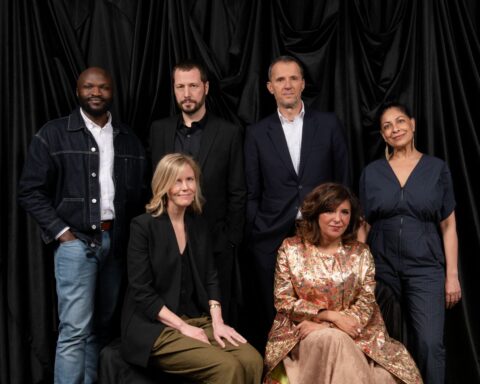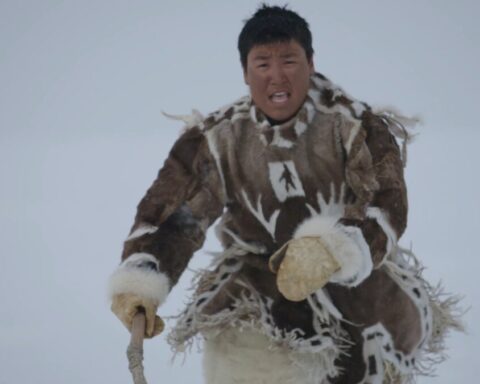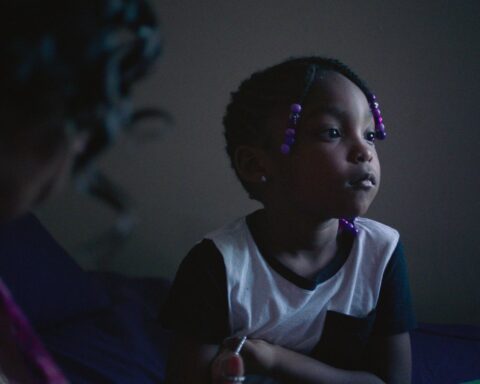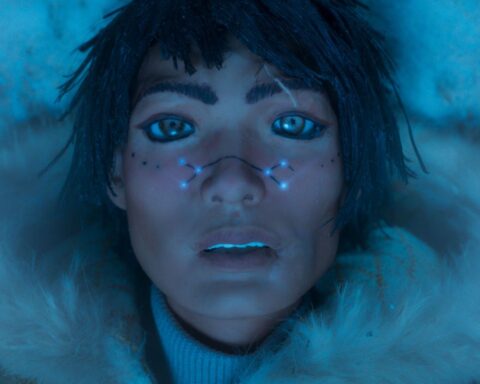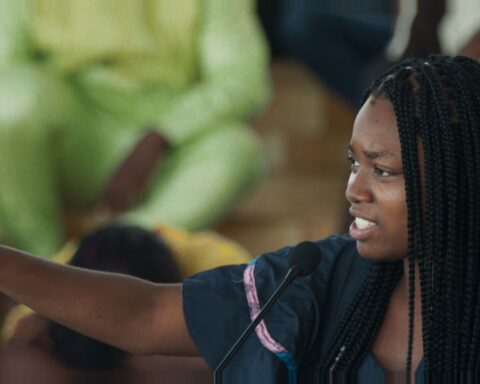DIRECTOR, CINEMATOGRAPHER AND WRITER JOHN WALKER is the complete package—a true filmmaker. His gifts are so abundant that he runs the risk of being praised for one aspect of his talent—his great camera eye—rather than for the overall quality of the work. Adding to this dilemma is Walker’s ability to branch out and experiment, taking on projects that range from a hard-hitting story of a First Nations’ tribe changing their lives (Place of the Boss) to a verité look at a year in a Toronto high school (Tough Assignment) to a musical profile of coal miners losing their jobs (Men of the Deeps). Diverse, yes, but held together by Walker’s humanism and deep sense of commitment to Canadian ideals—and scorn for those who would betray this country’s belief in social justice and opportunity.
Over the course of a couple of days—in interviews conducted together in Toronto and then, via phone to Halifax from Ontario—John Walker shared stories with POV‘s editor, Marc Glassman. It was fun—and remarkable. So remarkable that POV will run Walker’s interview in two parts. (Click here for part two)
In this section, John Walker describes his filmmaking career from 1990 though 2003. The next issue will feature frank talk with Walker about his current feature, Passage, and then move through his life and career from being a photographer in Montreal to the release of his award-winning doc, Strand—Under the Dark Cloth in 1989.
JW: John Walker
MG: Marc Glassman
MG: While you were finishing your film on photographer Paul Strand, Under the Dark Cloth, you were asked by the BBC to work on a series of films dealing with Stalin. What was your approach to the project, which became known as The Hand of Stalin?
JW: While I was working on the Strand film, I got to meet one of his friends, Cesare Zavattini, who wrote text for Un Paese, one of Paul’s books, and the scripts for a lot of great neo-realist films like Bicycle Thief. Zavattini was just such a wonderful human being. He spent the day feeding me and drinking and talking. He said he’d always had this dream, this idea to make a film on his home town. When Strand came to meet him, to do a book in Italy, they talked about what it would be about. And they were standing on a street corner in Luzzara his village, when Zavattini said, “we could pick somebody that just walked by and tell his story.” That has resonated with me since then, that we all have a story to tell.
So when we were planning the Stalin films, I told [the BBC] the story about Zavattini, which they liked. The idea was, “Let’s stick a pin in a map, take one village, one place, and that’s where we’ll tell the first story of what happened during the [great] famine.” And that became the first film, Leningradskaya—A Village in Southern Russia.
This is a film that looks at what happens in these people’s lives, rooted in oral tradition. And that was going to be the tenor for the series of films. It’s first person narrative. The second film, the pin was dropped in Leningrad. And it dealt with a very specific period after the famine between 1933–1936. Three or four years of interrogation and arrests largely directed towards the intelligentsia. Very specific. And that became our second film, Leningrad.
MG: What were you trying to achieve in Leningradsksaya?
JW: The metaphor for me was: I felt like this naive child who was walking up to the side of a stage, with a great big black curtain on it, right? Walking up to the stage and peeking behind this curtain and seeing this massive Hieronymus Bosch scene in full life, taking place. Of Hell. I knew I had a very powerful story and in the editing it was like holding back a race horse that wanted to gallop to the finish. It was a matter of slowly revealing the story with a lot of silence and landscape to punctuate, contain the horror of this great human suffering.
MG: And in Leningrad?
JW: We were now dealing with urban people who had to cope with Stalin’s paranoia. You know, the paranoia of a monster. It’s a very different story.
They were arresting millions of people and sending them to the Gulag on false evidence that they were international spies or “enemies of the people”. During the research we found lots of former NKVD [renamed KGB] who had been sent to the Gulag as well. But I felt we needed some witnesses who had remained in the secret service, that had not become victims. I needed those characters to make the film interesting. Otherwise it’s all about victims. I was made aware that the KGB were all over us when we were in Southern Russia. They were intimidating the Russians that were with us, but they weren’t intimidating us. And they weren’t interfering with us, but they were there.
MG: You could imagine what it would have been like before the end of the Communist era. They would have been intimidating you, too.
JW: That’s right. But this was the Gorbachev era of Glasnost and it was Kosher to speak about Stalin at this point. Or so we thought. We found out from one of our subjects that her interrogator, an ex-NKVD, was alive and well and teaching at a university in Leningrad. I thought this is perfect, just what we’re looking for. So we’re talking about this in the hotel room and I say to Liana Pomerantsev, who was one of our main researchers, “Okay, call him up. Tomorrow. Say we’re working with the BBC.” He’d just written a book on the French and Russian Revolutions. “Say that we want to talk to him about the book. Just to get in the door, and then we’ll see what we can come up with.” So she calls him up and he says immediately to her “Fuck off. I know what you’re up to.” Liana came back to me. She was completely shocked. “What does this mean?” It means that they’ve listened to all of our conversations. And he was warned.
MG: Yeah, that’s extraordinary. So among other things, your hotel room is wired. You know, just like those classic old spy movies.
JW: Right. So I now know, “Okay, they’re really on our case.” It’s one thing to be talking to peasants about a famine that took place a long time ago. It’s another thing to be talking about what happened in Leningrad with the NKVD, because the KGB is still operating. So I say “Okay. They’re listening. Let’s test Glasnost [openness].” We go to the KGB headquarters and ask them, “We’re doing this series on the Stalin period for the BBC and we would like to talk with some NKVD agents that operated through this period and are still around.” Sure enough a couple of days later, they come up with twelve names.
MG: Really? Well, that was a smart move.
JW: This is it, though. They said “you can interview these guys.” The one condition is that we have a KGB staff person at the pre-interviews. And we agreed. The guys come in. We have twelve amazing interviews. At the end of each interview I ask “Have they agreed to be in the film?” “No.”
MG: So these are just interviews and nothing was being taped. You weren’t shooting.
JW: We were only allowed to talk to them. The KGB had said “If they agree to be filmed, that’s their choice.”
MG: But of course, you realized that that’s bullshit, right?
JW: That’s why the researcher Liana and everyone else on the crew said “Well, what’s the point?” But I’d said, “Never mind. Let’s just do it.” And that’s what we did. We interviewed the twelve people. They all said no until the last one, or maybe the second last, agreed. And I said “What’s the caveat?” The caveat is that we have to have a KGB guy at the filmed interview. Fine.
So I go to do the interview. We go to his house. He’s wearing his normal clothes. The KGB guy is there, too. He’s a cold, steely-eyed guy. It was right out of central casting, pacing up and down the hallway in a trench coat. I go to the guy who’s agreed to be interviewed. I’d noticed a coat with all of his medals on it in the bedroom. I said “Would you mind getting a little dressed up here? Put your coat on?” “Fine, no problem.” He puts his coat on with all of the medals.
It’s a bright sunny day so we closed all of the blinds and set up this scene. We use his dining room table and put a dark table cloth on it, and lit it with a spotlight on him. Interrogation light on him. We set this up in his living room, And the interviewer is saying “Why are you doing all of that? You’re not going to get anything out of him.”
But we start taking him through it, asking him what he wanted to do when he first came to Leningrad. He starts talking about [how] he wanted to be a poet. He came from the country. He arrived in Leningrad and was made an offer that he couldn’t refuse and that was to join the NKVD.
He started to get in the role about interrogation. I set up a situation that was exactly the way he would have been interrogating people. He said “It was very much like this except the tables were turned. I was the one doing the questioning.” And then he said “But I didn’t send off my colleagues.” Blah, blah, blah. “I didn’t.” And that’s all we needed. And he went into his whole thing. He reveals all—what “other people” had done. But he says “It was not me. It was my colleagues. I never made the final order.” When this was intercut with victims who had survived the Gulag it was a very powerful counter point.
MG: Yeah, that’s a brilliant technique, of course. Get somebody to visualize a room and it’s amazing what will happen to them.
JW: And he’s wearing his outfit.
MG: Yeah, I love that.
JW: And when we walked out, the look on his face was “I said more than I had meant to…”
MG: At that point, you decided to come back to Canada to make Distress Signals instead of the third part of the Hand of Stalin trilogy. Why?
JW: The film was in the works for years and I had committed a delivery date to Channel Four, CBC and the NFB so I had to get on it. I wanted to make a film about Harold Innis and Distress Signals was my first opportunity to explore some of his ideas. He’s a totally inspiring and visionary thinker. He’s been called a shaman of the Canadian discourse on technology. Marshall McLuhan said that Innis discovered a flaw in Western Civilization. He’s the first person since the Greeks to think about the impact of technology on our consciousness. The flaw is that we adopt technology without thinking of and understanding its impact on our consciousness. Innis was the first philosopher to look at the alphabet and to say that it is a technology that led to the book, which, in turn, led Western civilization from oral tradition to a written tradition. So Innis is the first post-modernist, in a sense.
MG: So, when you came to this film —I mean, it’s a big topic—how did you decide to weave the strands? Because you’ve got the development of CNN, you’ve got a long sequence in Zimbabwe and you also have MIPCom [the big TV selling fair in Cannes]. It’s interesting to see these different elements in this film and I’m wondering why you made those choices.
JW: Well, what you had was the global market place. That was MIP. At the centre of the film was commercialization of media. What distinguishes America is that US TV is predominantly commercial. PBS is tiny in America. European broadcasters had been predominantly public broadcasters. A big attack was being launched against them.
This was the early 1990s. There was a huge threat with Silvio Berlusconi in Italy and Rupert Murdoch and other guys privatizing media in Europe. That was at the heart of it. We went to the market place, and asked, “How does it work?” And “Why, in television, do the Americans dominate?” They do. They dominate the global market. Not only in television but in film too.
We found that the Americans dominate in two ways. One is economic and the other is political. Distress Signals was a political/economic look at television and culture. The Americans dominate on the economic side by dumping their programs in other countries at a cheaper cost than those countries can produce them. And that’s how they make their product attractive.
From Canada, a first world country, down to a third-world country like Zimbabwe, they’re essentially playing that game. They make their product in America: they pay for it, they make their profit and then everything else around the world is gravy. So they can afford to sell it cheaper than it costs a domestic country to make it. It also attracts advertising dollars for the broadcaster who is buying it in their country.
It’s the Canadian model, right? We buy American programming cheap,and we sell advertising, and we make more money than if we make the drama ourselves. And it continues to destabilize domestic product. In Zimbabwe they give the product away for the price of the tape stock.
MG: But of course we do have a public sector, John. The NFB and the CBC. What about them?
JW: The public sector should take risks that the commercial sector can’t afford to. There should be more freedom. This is what Innis is talking about. The search for truth should not be encumbered by business or government influence. Innis fought for arms length institutions like the University. Commercialism has limits because it has to sell products. It’s limiting the imagination. It’s limiting what can go out on air. The public sector should be more free to explore more difficult territory. If Innis knew what was happening now, with universities and the public sector he’d be rolling in his grave.
MG: You then went overseas again and made two films that are linked in my mind, Orphans of Manchuria and Hidden Children. They’re both tragedies about how children’s lives were affected by the Second World War. First, how did you get involved in Orphans of Manchuria?
JW: A British journalist heard about this story in Japan. They were recalling Japanese orphans who were left in Manchuria after the war. They were going on television to find their families and they were moving back to Japan. They’d hold up a picture of themselves as kids and describe their moment of separation from their family. And describe their parents. And basically they’d wait for the phone to ring. It was extraordinary. He took the idea to October Films in London who I had done the Hand of Stalin with. And they contacted me and asked me if I wanted to direct it.
MG: While you were working on Orphans of Manchuria, did you already start the research for Hidden Children?
JW: Julia Sereny had found out about Jewish children who had been taken in by Christians during the War. There was this first public meeting of hidden children in New York that was coming up. It was like a coming out for them. It was interesting to me because many of these survivors somehow felt that they were second grade survivors. In other words, “If you hadn’t been sent to the prison camps then what would you know about the war, you were just children?”
MG: Well, they lost their families. But they hadn’t been in concentration camps.
JW: Yes, some felt that they hadn’t suffered as much as the families in concentration camps. So the whole sort of Jewish historiography had revolved more around the camps and the children’s stories had been left out of the mix. Now they were gathering together to share their stories. So Julia was researching that and she came to talk to me about it. And I said “This really fits The Orphans of Manchuria.” She went to October Films with the idea. And I said “You know, Julia, I would really like to make that film.”
I told her about my experience of growing up in a Jewish neighbourhood in Montreal and how I wanted to be Jewish, when I was a kid. Of course, all of my friends, a lot of the Jewish community in the context of where I was living were survivors. Most of my friends’ parents had numbers on their arms. I mean, talk about being imbued in the history. My close friend gave me a copy of the Pictorial History of Nazi Germany when I was eleven. I still have the copy.
MG: I’m wondering with the birth of your own daughter around the same time, did you find a particular resonance in your own life to be thinking about these children?
JW: What those two films showed was the lasting impact of war on children. I mean, these children experienced war fifty years previous to us making the films. So yes, there’s no question that having a child and thinking about impact of war was resonating.
Also, I have to be honest, Orphans of Manchuria was harder for me to connect to culturally. And it did raise questions for me. You know, “What am I doing here?” Japanese culture is so alien to me. I mean, it’s a human story but I always think very carefully about diving into other cultures.
MG: You returned to Canada after those two films and made a very local film, Tough Assignment. Why did you make the film about Oakwood Collegiate in Toronto, which is so different from the others?
JW: Tough Assignment was a conscious effort on my part to do two things. One, I didn’t want to do any more tragedies—at least for a while. I wanted to do a film that I wasn’t going to cry on. And I wanted to make a verité film. I had shot a lot of verité films but never directed one. I’m never happier than when the camera is on my shoulder and I’m glued into something.
The thing with a lot of the other films I had done, you know, biography, artist, history, there is a line there. There’s a structure. There’s the structure of a life. There’s the structure of an event. There’s a structure that you’re working with. Not the structure of the final film but there’s a line there that you’re following. When you do a verité film, it’s different.
The idea to do the film came from Tom Perlmutter. Because his partner, Chris Wright, is a wonderful teacher. So that was the idea, to make a film about teachers. I said “Yes, that’s a great idea. I want to do this.” Because both of my grandmothers were teachers. My aunt and uncle were teachers. My sisters are both teachers. It runs in the family.
MG: You were shooting seven teachers to begin with, and you got down to four. One of whom I really like—the old guy. He was a damn good teacher. Clark. He impressed me.
JW: And Callabro. Callabro is good. The interesting thing is, it’s so simple. You go through all of this and you spend a whole year there and it comes down to one simple driving factor. What does it take to be a good teacher? Respect. If you respect your students, they will respect you. Pure and simple, that’s it. Game over. That’s all you need to know. And yet, so many teachers didn’t get it. Some of them didn’t like kids. And others, it’s not that they didn’t like them, it’s that they didn’t respect them.
MG: Was it hard to return to a truly dark emotional terrain for Place of the Boss: Utshimassits?
JW: Well, what made it very hard was realizing that it was a tragedy on our soil. And it compared to Orphans of Manchuria and Hand of Stalin.
MG: Yes. The story of Innu and of the nomadic tribe that never should have been forced to be placed in a situation that was totally alien to their history and heritage. It’s an amazing story.
JW: The Innu are unique because they resided in the territory of Labrador, which was not a part of Canada until 1949. So they were never integrated into the Indian Act. But in the 1930s and ’40s the Innu were forced to the coast because the caribou were failing and they were starving. Fortunately, at first, there was an Irish Catholic priest there [named] O’Brien, who helped them.
So this is a film that includes two strands of Catholicism. I bring in the Jesuits and the Irish Catholics in this film, in terms of who they had contact with. And the Jesuits, going back to Paul Le Jeune in the early Quebec settlement days acted on the edict: 1) Stop First Nations people from wandering. 2) Destroy their language. Get them into schools and change their language and get them into a community and settle them. Basically, it was cultural genocide. They’d steal the drum. They’d forbid the shaking tent ceremony. They prohibited shamanism. That’s what the Jesuits did right across the country. Prepare the ground for the French settlers to come in and take over. You know. Tame them.
MG: But of course, this is 1950—not 1650—at this point.
JW: In 1950 the Innu were still fine, culturally. The Jesuits had given up on them 200 years earlier. They’d tried to get into that territory and couldn’t. But they’re back at it in the 1950s. And this time they were successful.
MG: Looking at the film, it’s amazing to realize how quickly the Innu lost their traditional way of life and succumbed— many of them—to alcoholism and poverty. How did you become involved with them to make the film?
JW: An incident happened where a house had burnt and children had died. And the community had gathered to say “Enough. We have to heal and we have to turn ourselves around.” So I went up to the community and met with the band council. And I said “Look. We’re interested in making a film. Are you interested? Is this something that you want to see done? If it isn’t, I’m out of here. I’ll be out of here as fast as you can say ‘get on the next plane’.” We sat down and we talked and they very much wanted a film. They wanted their story told to the outside world because they felt that it was the only way that they were going to get help.
MG: Were the Innu pleased at the film’s success?
JW: Yes. When we won the Donald Brittain award [for best social-political documentary broadcast on Canadian TV], what I was feeling at the time was that it was really great for the community because it’s their story and for me it was the recognition of their story. I think they were pleased that it won an award. Because it was their family stories.
MG: Fairy Faith seems like a very personal project. First of all, you are in it quite a bit more than anything up to that point, and really for the first time you’re referring to your own roots, both Irish and Scottish.
JW: The film opens with my grandmother. I had started reading [the Nobel prize winning poet] Seamus Heaney. And reading Irish mythology. I was really getting into my roots. I was looking for a challenge. I thought to myself, “Do you use your imagination in documentary?” Or are you just in the real world? Then it just came to me. I’ll make a film about imagination. And then the fairies emerged. I think they sprinkled fairy dust on me or something.
When this emerged as a subject, I went back to thinking about my grandmother, who had really saved me. I was having a hell of a time in high school. I was seen as a troublemaker and I wasn’t doing well. And she said to my parents at the end of grade eight, my first year of high school, “Give him to me for six months. I’ll straighten him out.” And she took me over to the UK, to England and Scotland and for six months, imbued me with a sense of history. Took me to see Shakespeare. It really gave me a grounding and influence in terms of my films later. What she taught me is that Shakespeare works on all kinds of levels. Political, cultural, historical. And he’s got humour for the masses. He doesn’t speak down to anybody.
She said “Stand on your left foot. There’s this rational world where we have to make a living and do our homework. Now stand on your right foot. There’s another world. It’s a world of the imagination. It’s a world of mythology and fairies”. And she’d talk about this other world. And she was a great believer in the fairy stories and the fairy faith. And she showed it to me in Midsummer Night’s Dream. They’re in Shakespeare. They’re in Blake. Their mythology is at the roots of the imagination. So she opened me up to this at a very critical age of thirteen when you’re starting to become very cynical and losing your imagination.
MG: I was wondering about how you selected your characters. Where did you find them?
JW: The first guy is Peter Aziz, who’s way out there. He’s seeing fairies as we’re standing there with the camera. And he’s got me looking for them! Am I losing my mind? And then you have Dr. Mark Fox, who’s written all sorts of books about the paranormal—where is the imagination, what is it. That establishes the structure. Because we followed Peter with Fox, who is more of a rationalist. He’s English. He comes from the rational world and yet he’s open to the possibility of the paranormal and tries to define it in sort of a scientific way. And then we have a harpist, Elizabeth Baldry, who I met at a great exhibition on Victorian Fairy painting at the Royal Academy of London. And that was another thing that I’d seen. Arthur Rackham’s illustrations and all of those characters. I thought that was a way to visualize that. Wonderful imagination. And I discovered in my research that William Blake was the first one to draw diaphanous wings on fairies. He saw a fairy tea party in his garden, his back yard. And here’s Blake, you know? The great imaginative poet. So that’s when I started understanding that was what this was about. And that people were trying to visualize them like Brian Froud, who is in the film as well. So all through the process of making the film I was back and forth questioning my imagination with a rational mind that kept wondering “am I was losing it”. So now I say if you can tell me where the imagination comes from, then you’ll know where the fairies live.
MG: Fairy Faith is all very beautifully done, but for most of it, we’re somewhere else. Not in Canada. And then all of a sudden, at the end of the film, you go “Oh, but guess what. It actually is just as true here in your back yard with Native People.” And I found that extremely exciting. When did you encounter the people that you ended up putting into that film?
JW: I had met this former Police Chief in Cape Breton who had second sight. Not only did he have second sight, but he believed in fairies. I thought “Okay, I’m going to go up to Cape Breton, I’m going to shoot him for the opening of the film.”
So off I go to Cape Breton and while I’m driving on the way to the interview, I see this hill. And it looks like a fairy hill—just like the places in Ireland and Scotland we had seen, where fairies live. The clue for me was that right at the top of the hill was a Christian cross because the Christians always put crosses on ancient pagan sites to colonize them. So I pull into the base of this mountain, just to investigate.
And it happened to be on a native reserve. At the bottom of the hill is their community centre. So I go in there, very tentatively. There’s a secretary, and I say to her, “I’m interested in this mountain and how that cross got up there. Just inquiring. Is there anyone I can talk to?” She says, “Well, they [the elders] are just in a big meeting here. They’ll be out in about five minutes.” So I wait and start talking to her. And she says, “So what are you doing?” And I say, “Well, I’ve been over to Scotland and I’m doing a film about fairies.” So she says, “Oh, what do you mean?” And I reply, “The little people.” And she looks at me and she says a word in her language sounding like “wodaladamoosh”. And I ask “What did you just say?” “The little people.” And I say, “Yeah, that’s right.” Suddenly, she’s excited. “Oh, jeez. Well wait right here.” Sure enough, people came out. And she tells one of them what I’m up to. And he looks at me and says “Oh, jeez. You want to be careful doing that.” And we all started talking and everyone had a story. I was just completely amazed. And I thought “Okay, here’s the ending of the film.”
MG: And finally Men of the Deeps.
JW: The approach with Men of the Deeps was to have the songs integrated into the film. I wanted the testimonies and the portraits of the men and their songs to tell the overarching story. It wasn’t just cutting away to music and hearing random songs—the very shape of the lyrics would shape the story.
MG: It’s just about seamless and very well thought out.
JW: It’s one of my favorite films. It brought me back to one of my first cinematography jobs for Budge Crawley. We made a film in the uranium mine in Elliot Lake. This was the ’70s. I met all of these Cape Breton coal miners who were working in the mine. There was a Cape Bretoner who was on the cage going up and down the shaft. We were going down what seemed like half a mile down. And every day he had a different joke. And it was a long involved joke. And when the cage opened up and out you went for the day, he’d hit the punch line and you’d all go out laughing.
I fell in love with Cape Breton coal miners. They’re performers. Over the years, it’s always resonated with me. I read Alistair McLeod’s short stories about the coal miners leaving Cape Breton and driving up to Elliot Lake. And then I got wind that the last coal mine in Cape Breton was closing. At the same time, [NFB producer] Kent Martin said “You know, the Men of the Deeps did some music for the Westray film [by Paul Cowan].” And those two things clicked. I thought “The Men of the Deeps and the closing of the last mine in Cape Breton.” I called up Men Of The Deeps right away. It was now or never to make the film.
MG: Can you tell me how you got the guys to be so natural when they were telling their stories?
JW: It was interesting because I’d go to their homes. What I discovered is that the miners were very shy when I would go to the one-on-one in the living room. And I found the wives would be shouting “He loves the danger!” And they’d be yelling at me from the other room. I thought I was going to have to call it “Women of the Deeps” because they were telling me all of this stuff and they were vocal. And the guys would just sit there and go “Oh, no. I didn’t do very much. I was just making a living, you know.” I didn’t get anything out of them.
Finally I realized, it’s when these guys hang out together—it’s another world underground—that’s when they come alive. Not when they’re sitting in the living room with their wives. So I realized, this is a film about camaraderie and the collective working together. That’s what it’s about. That’s what I experienced in Elliot Lake. So I said, okay. I’m going to start shooting these guys together. And sure enough, you get a couple of guys together and bingo. Then they get going, you didn’t have to ask any questions.
MG: And I love that expression “What’s said in the mine stays in the mine.”
JW: And that’s exactly what it was. Because it was two worlds. In Elliot Lake, every second word was fuck. As soon as they head to the surface, not a swear word. Gone.
For more on the life of John Walker, including his early days as a photographer and his latest film, Passage, read part two of our exclusive interview.




